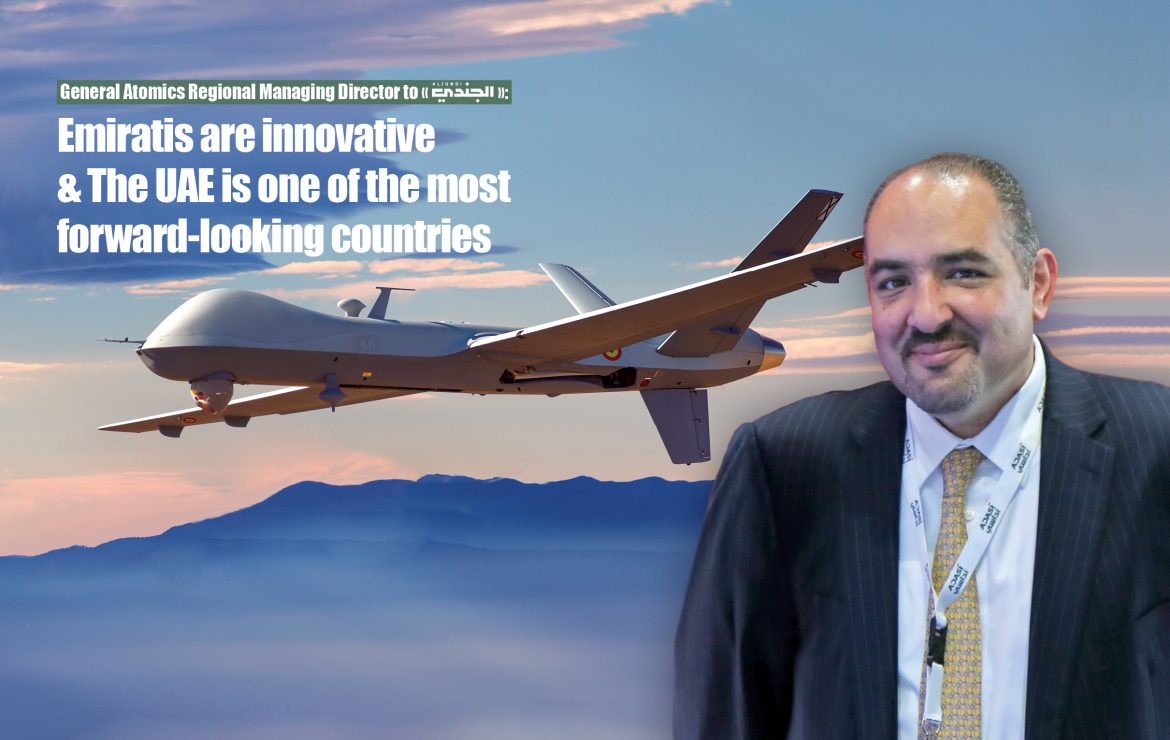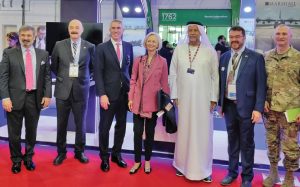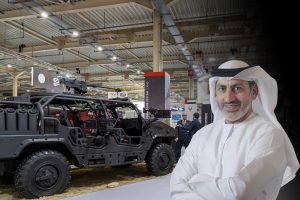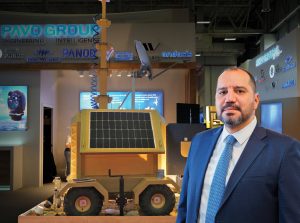As General Atomics, a US aerospace, defence and technology company and world-class unmanned systems provider, maintains very good relations with the UAE and contributes to its unmanned systems development, Al Jundi Journal, met with Mr. Tamer Aly, Regional Managing Director of Business Development for Mid- East and North Africa and discussed with him, the relationship with the UAE, their newest aircraft especially the weaponized ones, their capabilities, their game -changing technologies and some other related issues. Here areexcerpts:
How do you assess your relationship with the United Arab Emirates (UAE)?
We have maintained a very good relationship with the UAE in the past ten years. This relation was culminated in delivering the UAE S and Project EV unmanned aircraft. We also try to bring the most modern aircraft to the UAE.
Can you give us an overview about General Atomics (GA) history, its products and whether you manufacture the Predator series of unmanned aerial systems only, or you have other UAS types as well?
GA has a very long history. We’ve pioneered the unmanned aerial systems (UAS) in the medium altitude, long endurance (MALE) category which is the Predator’s series of aircraft and the most prominent and flies all over the world. At any given moment, there are seventy Predator series aircraft flying missions all over the world in every moment. So, it is very heavily used system. It has flown 6 million flight hours up to this year and continues to grow through its use at the rate of 600,000 hours per year. So, it’s not only the pioneer in the space, it is the world standard. Our newest variant of that aircraft is the MT 9B, the Sky Guardian, not only the newest, but it builds on the history of those six million flight hours and creates a system that addresses the mission challenges, that our customers would depend on the system when they see it going forward amongst them with the ability to fly anywhere. So, any military aircraft especially unmanned tends to be restricted with what is called restricted aerospace, aerospace that is closed after our commercial traffic, just to allow these unmanned military aircraft to fly. The MQ-9B addresses that by being a fully-certified platform. A certified MQ-9B can fly in a mixed aerospace along with commercial air traffic. In that by itself is one element of the game-changing technologies that allow this system to fly in due more missions for customers. On top of that, the next largest advancement in this new system is that it flies %100 of its missions with the Satcom, the first ever for an unmanned system. What that means for our users is that they can fly the system and send it to a forward location without sending a large number of people and equipment to support it. They just send the aircraft, one or two technicians, a laptop and small pieces of equipment. This is a game -changer. So, with that the entire operation can be centralized and it keeps the staff for the armed forces at home and allows them to fly more and save great expenses for the operator by having everyone centralized in his location. With that we’ve removed the tether, we removed the rope, that even in those unmanned, there is still a reliance on having a what they call in-line-of sight link to control the aircraft, and we completely removed that tether. So, now this the most flexible, most mission-capable aircraft we have ever produced. While we did that, we mean an aircraft that flies long endurance and carries more payload which is, from an engineering point of view, something of a miracle. So, General Atomics has a history of doing that, of developing game-changing innovations before our customers even ask for it.
There are mulit applications for UAS systems, but GA is very well known for producing weaponized UAVs (UCAVs), Where is the trend going now? What kind of UASs are mostly needed now?
Weaponizing unmanned systems is nothing new. It’s been around for quite some time. Yes.
But you started it, didn’t you?
General Atomics optimized it, made it more reliable, and made it a precision weapon, and created the credibility it has achieved. No doubt about that. But to characterize the system as only a weaponized platform is inaccurate description. I’ll explain the primary mission of UAS by defining a weaponized system. An F-16, or any other fighter aircraft, is an extremely capable strike platform. Apache AH-64 helicopters by Boeing are laudable weapons and do a fantastic job of striking. The main difference between fighter and combat aircraft or strike aircraft and an unmanned system is the ability of the unmanned system to collect data, information. Manned strike aircraft are limited in their ability to collect information and help decision –makers to make a fully informed decision on a potential target. The primary benefit of UAS is its ability to fly for a long period of time with powerful sensors that can collect the information that fully informs the decision-makers on making their own decisions on to strike or not strike. Forty hours of endurance allows 24- 27 operations in a very easy fashion with very powerful sensors as we say in Satellite Communications Agency (SATCOM); allows information to be gathered, analysed and decisions to be made with as much as close to %200 accuracy. We in General Atomics look at it as ” decisions in the battlefield are best made when decision makers are fully informed”. There is no system to do that better than General Atomics’ UAS, whether it the MQ-9 Reaper or our current system the MQ-9B Sky Guardian. These systems have primarily turned around the term ISR, but persistent ISR is a different game altogether. Persistent ISR is about the ability to collect data to fully inform the decision. That’s the primary role of the aircraft.
Unmanned systems are playing more important roles in air battles, from your point of view, how much percentage of these systems will be seen in future mixed air battles?

There will be greater dependencies on UAS systems in future battles, no doubt about it. Once users get used to that level of situational awareness, and we’ve seen this time and time again, that level of data gathering and analysis in the real time are afforded by systems like MQ-9B Sky Guardian and are supported in greater intelligence, etc. Once a user or a fighting force is accustomed to that level of information, it’s hard for them to go back to making less informed decisions in the battlespace. That dependency drives more use, more use drives more technologies, and greater levels of situational awareness. The ideal state is where civilian casualties and these things are a thing of the past, because of informed decisions to the warfighter.
But what about the ethical responsibility behind using fully autonomous weaponized systems?
These systems are not fully autonomous. There is always a human element in the decision making. That’s how these systems have been designed and we still continue to design them.
These systems are mostly used in uncontested environments. Do you have any plans to produce versions with self-defence capabilities to be able to work in a contested airspace?
I can tell you one thing that these systems have been designed to work in uncontested space.
- As you know there is strong trend towards producing UAS counter systems, do you have plans to follow this trend in future, and to what extent are your systems immune to those counter- UAS systems?
General Atomics aeronautical systems is a premier UAS systems manufacturer company. That’s our prime business. We are not a counter-drone system developer. I told you earlier that our systems have done more than six million flight hours. We, whether in the US air force or in air forces around the world, are consistently the highest performing availability wise; a mission available, aircraft available standpoint and that reliability and that mission capability has a lot to do with the way the system is designed and its safety and ability to fly without too much away impact from counter efforts. So, the system is designed to successfully complete the mission in spite of those issues that play lesser systems.
As you know United Arab Emirates is focusing on building defence industry base through holding joint ventures with renowned high- tech companies, like yours, to what extent are you ready to contribute to supporting our defence companies’ industrial capabilities?
We are in constant discussions with our friends at Tawazun and with the UAE government potential opportunities to develop their technology not only in space but also elsewhere. General Atomics is a very diverse company. We have lots of innovations and high-tech solutions in commercial and energy environments and those are as important to economic success and future of the UAE as defence technology. So, opportunities for UAE and General Atomics to work together is far beyond the aerospace and defence.
What do you think of UMEX Exhibition as a spcialized exhibition and exhibition industry in the UAE in general, and how do these exhibitions contribute to developing defence and aerospace business?
We’ve been part of UMEX and some other shows since the beginning. To see UMEX grow the way it has and become more important, we are talking about UAE as an innovator. To put together trade shows specifically for unmanned systems is a very bold move, and to break it apart from IDEX was very smart because it requires focus. It’s growing in a different rate in comparison with the rest of the defence world. As usual, the UAE is the first of doing something and do it successfully. We have seen UMEX grow. We have to be part of it and we hope to see it, along with other exhibitions, grow further and prosper.
Another point I’d like to make. The one main difference I have seen from UMEX, IDEX or Dubai Airshow is the level of the UAE leadership involvement in the Show. We have been so fortunate to get to spend time with HH. Sheikh Mohamed Bin Zayed Al Nahyan, Crown Prince of Abu Dhabi and Deputy Supreme Commander of the UAE armed forces in 2018 event. He was very generous not only with General Atomics, but also with many other exhibitors who were here. That’s such a privilege that you can’t put price on it. To see the country’s leadership so involved, means that they are focused on watching the unmanned space and technologies grow in the country and that pushes companies like General Atomics harder to help the UAE realize their future.
How do you assess the cooperation between your company and the United Arab Emirates?
Our relationship with the UAE is excellent. We are lucky that our relation with the UAE is not based on buying and selling. It’s a true partnership where we look far past the product itself. We think together about the challenges and we come up with good solutions, and I think the UAE appreciate this from us, and we appreciate them letting us in trying to do our best and find the best way to help them. And just in front of the challenges that are meeting us, we have a very long-term outlook for our involvement and presence here in the UAE and that includes establishing our subsidiary here in the UAE and working closely and helping to grow technology and innovation that start here in the UAE. We are very excited.
Our efforts here in the UAE have come from a long history of mutually successful and mutually appreciative work, but we’d like to say it’s just the beginning. We see, hopefully very long future for not just General Atomics quest, but for the UAE in these technologies, in the space. They are innovators in the area and respectfully one of the most forward-thinking countries in general, but in the armed forces as well, and that’s a privilege for General Atomics to work with a country that thinks that way.
Interviewed by:Mohamed Fahed AL Halabieh » Photography by: Mohammed Al Shaer













